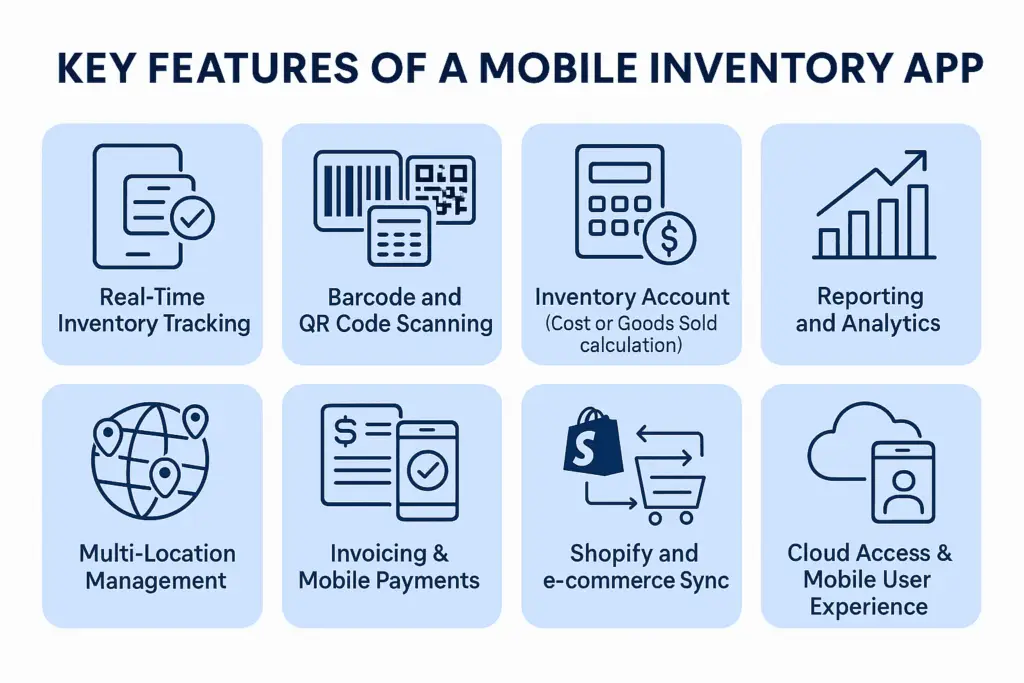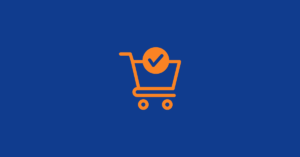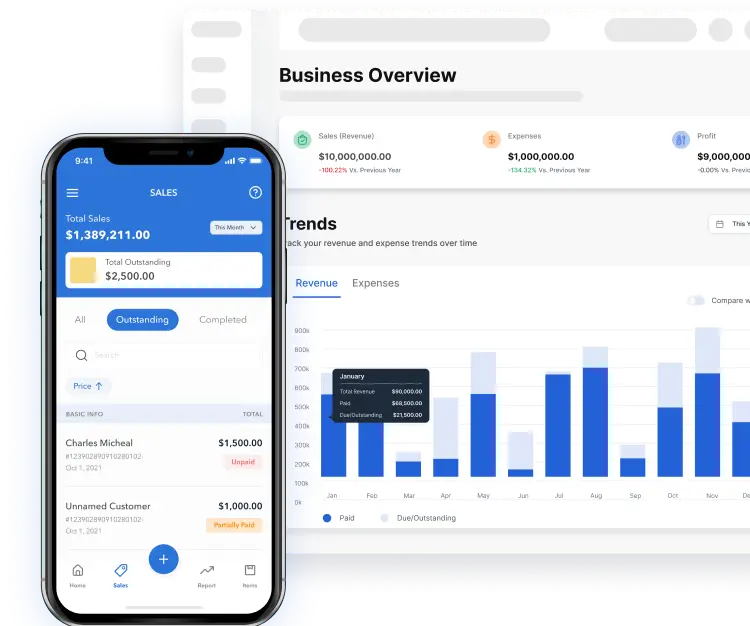Imagine you’re running low on a top-selling product, but you don’t know until a customer complains. Or you reorder something you already had in stock. Manual methods like spreadsheets can’t keep up with the speed of modern retail and distribution. That’s where mobile inventory software comes in.
Mobile inventory solutions provide real-time visibility, faster decision-making, and total control — wherever you are.
In this guide, we rank the top 10 mobile inventory software apps that do more than track stock. These tools help you manage sales, accounting, COGS, payments, and e-commerce, making them perfect for businesses ready to scale beyond spreadsheets.
Why Inventory Tracking is important
Frequent stockouts and excess inventory can hurt a business by leading to lost sales, reduced customer loyalty, unnecessary costs, and poor cash flow. Stockouts frustrate customers and push them to competitors. On the other hand, excess inventory ties up capital, takes up storage space, and risks spoilage or obsolescence, especially in industries such as food, cosmetics, or seasonal retail. Both issues reduce available cash flow, tie up capital unnecessarily, and cloud decision-making with inaccurate data. Over time, poor inventory visibility becomes a silent business killer, leading to missed opportunities, margin erosion, and even full business failure if left unchecked.
How We Ranked Mobile Inventory Tracking Software
To ensure this list is useful for real business owners, we evaluated each app based on a balanced set of criteria that reflect practical business needs and user experience:
- Key Features: We prioritized tools that offer essential inventory management capabilities such as barcode scanning, real-time tracking, detailed reporting, COGS tracking, and integration with accounting or sales platforms.
- Ease of Use and Mobile Experience: Apps must offer intuitive, mobile-optimized interfaces that support smooth navigation and fast actions, ensuring adoption by busy staff and business owners.
- Scalability and Flexibility: Whether you’re just starting or scaling across multiple locations, the app should grow with your business without requiring a major system overhaul.
- Pricing and Value for Money: We considered both free and paid plans, evaluating the value each solution provides relative to its cost. Hidden fees or overly complex pricing models were a drawback.
- Customer Support and General Reviews: While we did not link to individual reviews, we looked for consistent praise regarding responsiveness, onboarding help, and troubleshooting support. Platforms with strong communities or resources earned higher marks.
Together, these criteria helped us create a ranking that’s not only useful for comparing features but also actionable for real-world decision-making.
Top 10 Mobile Inventory Software Apps for Small Businesses (2025)
(Full app summaries follow this table below)
| App | Inventory + COGS | Shopify Sync | Invoicing | Payments (Stripe/PayPal) | Accounting | Starting Price |
| Vencru | ✅ (built-in) | ✅ | ✅ | ✅ | ✅ | Free–$50 |
| Sortly | ❌ | ❌ | ❌ | ❌ | ❌ | $0–$49 |
| Zoho Inventory | ❌ (needs Zoho Books) | ✅ | ✅ | ✅ (limited) | ✅ (with Zoho Books) | $0–$59 |
| Bino Inventory | ❌ | ❌ | ❌ | ❌ | ❌ | Free |
| Shopify POS | ❌ | ✅ | ✅ | ✅ (Shopify Payments) | ❌ | $39 |
| Fishbowl Go | ✅ | ✅ | ❌ | ❌ | ✅ (with Fishbowl) | $99+ |
| Odoo Inventory | ✅ | ✅ | ✅ | ✅ | ✅ | Custom Pricing |
| Square Retail | ❌ | ❌ | ✅ | ✅ (Square Only) | ❌ | $0–$60 |
| Stock&Buy | ✅ | ✅ | ❌ | ❌ | ✅ | $60+ |
| Katana | ✅ | ✅ | ✅ | ❌ | ✅ | $99+ |
1. Vencru
Vencru is a mobile-first business management app designed for retailers, wholesalers, and distributors. It combines inventory tracking, invoicing, accounting, and payment processing in one platform. It is available on iOS, and Android.
Key Features:
- Real-time inventory updates with multi-location support
- Integrated invoicing and quotes from mobile devices
- Double-entry accounting with automated COGS tracking
- Accept payments via Stripe and PayPal; sync with Shopify
Pros: All-in-one tool, easy to use, mobile optimized, great for financial visibility
Cons: No offline mode
Best For: Small to medium-sized inventory-based businesses looking for a unified mobile solution.
Price Range: Free plan available; paid plans range from $5 to $50 per month
2. Sortly
The Sortly app offers a visual inventory tracking system that’s highly customizable and great for cataloging items with images.
Key Features:
- QR and barcode generation/scanning
- Image-based inventory entries
- Offline access for mobile use
- Custom tags and folders
Pros: Intuitive interface, ideal for non-technical users
Cons: Lacks invoicing, accounting, and payment features
Best For: Small businesses or organizations needing simple visual tracking
Price Range: Free to $49/month depending on plan and features
3. Zoho Inventory
Part of the larger Zoho suite, this app is focused on order and inventory management for growing eCommerce businesses.
Key Features:
- Multi-channel sales management
- Integrates with Shopify, Amazon, Etsy, and more
- Delivery tracking and customer notifications
- Basic invoicing and payment integration (via Zoho ecosystem)
Pros: Excellent for eCommerce integration
Cons: Full accounting requires Zoho Books
Best For: e-commerce businesses using or planning to use Zoho ecosystem.
Price Range: Free plan available with limited features; standard plans start at $59/month
4. Bino Inventory
Overview: A basic Android-only inventory tracker with offline access and simple item cataloging.
Key Features:
- Manual stock adjustments
- Barcode scanning
- Simple reports
Pros: Free and easy to use for basic inventory needs
Cons: No cloud sync, limited reporting, Android only
Best For: Solo entrepreneurs or mobile field inventory tracking on Android.
Price Range: Free
5. Shopify POS
Overview: Designed for businesses already using Shopify, this POS tool unifies in-store and online sales.
Key Features:
- Integrated with Shopify’s online store
- In-app inventory adjustment and transfers
- Accepts various payment types including Shopify Payments
- Real-time inventory sync
Pros: Seamless Shopify integration
Cons: Lacks accounting or advanced inventory control
Best For: Shopify users needing in-person or online sales tools.
Price Range: POS Lite included with Shopify plans; POS Pro starts at $89/month per location
Related: How to Generate an Income Statement for Shopify Business
6. Fishbowl Go
Overview: A mobile extension of the Fishbowl desktop app, ideal for warehouse-level inventory operations.
Key Features:
- Barcode scanning for inventory transactions
- Purchase order receiving and picking/packing
- Integration with Fishbowl Inventory and QuickBooks
Pros: Tailored for large inventory operations and warehousing
Cons: Not standalone; complex setup
Best For: Warehouses and manufacturers with large stock volumes.
Price Range: Starts at $99/month depending on number of users and modules
7. Odoo Inventory
Overview: Odoo is a modular ERP system, and its inventory module is robust, customizable, and integrates with other Odoo apps.
Key Features:
- Warehouse management with barcode support
- Custom workflows and automation rules
- Full traceability and stock valuation
- Integrates with Odoo Accounting, CRM, and more
Pros: Highly customizable and scalable
Cons: Steep learning curve; cost scales with modules
Best For: Medium to large businesses needing ERP-level customization.
Price Range: Custom pricing; typically ranges from $25–$100/user/month depending on selected modules.
8. Square Retail
Overview: A POS-focused inventory tool built for small businesses using Square Payments.
Key Features:
- Real-time stock alerts
- Integrated payment processing
- Easy setup and quick checkout
- Employee management tools
Pros: Streamlined for in-store selling
Cons: Weak inventory features compared to competitors
Best For: Small retail stores prioritizing ease-of-use and fast setup.
Price Range: Free plan available; Plus plan starts at $60/month per location
9. Stock&Buy
Overview: The mobile inventory software focuses on inventory forecasting and multi-channel selling. This tool integrates deeply with Shopify.
Key Features:
- Demand planning and forecasting
- Product bundling and BOM support
- Order fulfillment across channels
- Shopify and Xero integration
Pros: Strong forecasting and multi-channel capabilities
Cons: Lacks payment integrations
Best For: Businesses forecasting demand across online channels.
Price Range: Starts at $60/month
10. Katana
Overview: Katana helps manufacturers manage inventory, production, and orders from one visual dashboard.
Key Features:
- Real-time production planning
- Raw materials and finished goods tracking
- Shopify and WooCommerce integrations
- Visual sales and manufacturing workflows
Pros: Great for production-oriented businesses
Cons: Expensive and lacks mobile payment support
Best For: Manufacturers and product makers with complex workflows.
Price Range: Starts at $99 per month.
Essential Features in Mobile Inventory Software (And Why They Matter)

The key features a mobile inventory management app should have are
- Real-Time Inventory Tracking
- Barcode and QR Code Scanning
- Inventory Accounting (Cost of Goods Sold calculation)
- Reporting and Analytics
- Multi-Location Management
- Invoicing & Mobile Payments
- Shopify and e-commerce Sync
- Cloud Access & Mobile User Experience
Real-Time Inventory Tracking:
Knowing your inventory status instantly allows you to prevent stockouts, overstocking, and missed sales opportunities. For example, if a top-selling item runs out during a weekend sale, real-time updates enable immediate restocking or order adjustments, preventing revenue loss.
Barcode and QR Code Scanning:
Manual stock checks and order fulfillment are time-consuming and error-prone. Barcode scanning automates these tasks, reducing human error and speeding up processes such as inventory audits, stock replenishment, and delivery confirmations — especially in high-volume retail or warehouse environments.
Inventory Accounting (COGS):
Many businesses focus on revenue but overlook costs. Accurate COGS tracking links each sale to its associated inventory expense, helping you calculate true profit margins. For instance, if you’re selling goods with fluctuating purchase prices, tracking COGS prevents overestimating profitability.
Reporting and Analytics:
With data-driven insights, you can identify which products are best-sellers, spot seasonal trends, and forecast future demand with confidence. This empowers smarter purchasing decisions, reduces overstocking or understocking, and supports more accurate budgeting and cash flow planning. For example, a retailer can use sales reports to reorder fast-moving items before they run out, while a wholesaler might use trend data to cut slow-moving stock. Robust analytics also allow business owners to track employee performance, customer buying patterns, and supplier reliability — all from their mobile device.
Multi-Location Management:
A mobile inventory system with strong multi-location support ensures that all your stock levels, transfers, and performance reports are synced in real-time. This centralized approach helps you optimize inventory distribution, avoid stockouts at key locations, and improve fulfillment efficiency — all of which directly enhance customer satisfaction and cash flow.
Invoicing & Mobile Payments:
Businesses lose time and money when billing happens days after a sale. Mobile invoicing lets you send invoices or receipts on the spot, while Stripe and PayPal integrations allow you to accept payments immediately. This improves cash flow and enhances professionalism in the field.
Shopify and e-commerce Sync:
Online and offline inventory systems that aren’t connected often result in double-selling, delivery delays, and unhappy customers. Shopify sync ensures that your stock levels, orders, and sales channels stay in perfect alignment — a must-have for multichannel retailers..
Cloud Access & Mobile User Experience:
Inventory management shouldn’t require being tied to a desk. Cloud-based systems with intuitive mobile apps allow business owners and employees to check inventory, fulfill orders, or approve restocks from anywhere. Whether you’re at a supplier meeting or managing multiple store locations, mobile-first design improves responsiveness and control.
If you’re still updating stock manually or toggling between apps for payments and reports, you’re wasting time and risking errors.
How to Choose the Right Inventory App for Your Business
- Define your inventory complexity: Do you sell in multiple locations? Have product bundles? Need manufacturing-level controls?
- Check for payment options: Stripe and PayPal can save hours on invoicing and reconciliation.
- Think about growth: Will the tool scale with new locations, employees, or integrations?
- Prioritize usability: Your team should be able to use it easily on the go.
- Don’t forget reporting: Dashboards should help you make better purchasing, pricing, and stocking decisions.
Conclusion: The Mobile Advantage — Inventory and Beyond
The best mobile inventory software doesn’t just help you track what you have — it helps you grow. Whether you manage a retail store, wholesale business, or manufacturing operation, choosing the right tool can reduce administrative overhead, improve profitability, and help you make smarter decisions every day.
Vencru stands out because it ties everything together: inventory, invoicing, accounting, Shopify sync, and payments — all from your phone.
Ready to ditch the spreadsheets? Start your free trial of Vencru and streamline your inventory, finances, and operations in one app.






